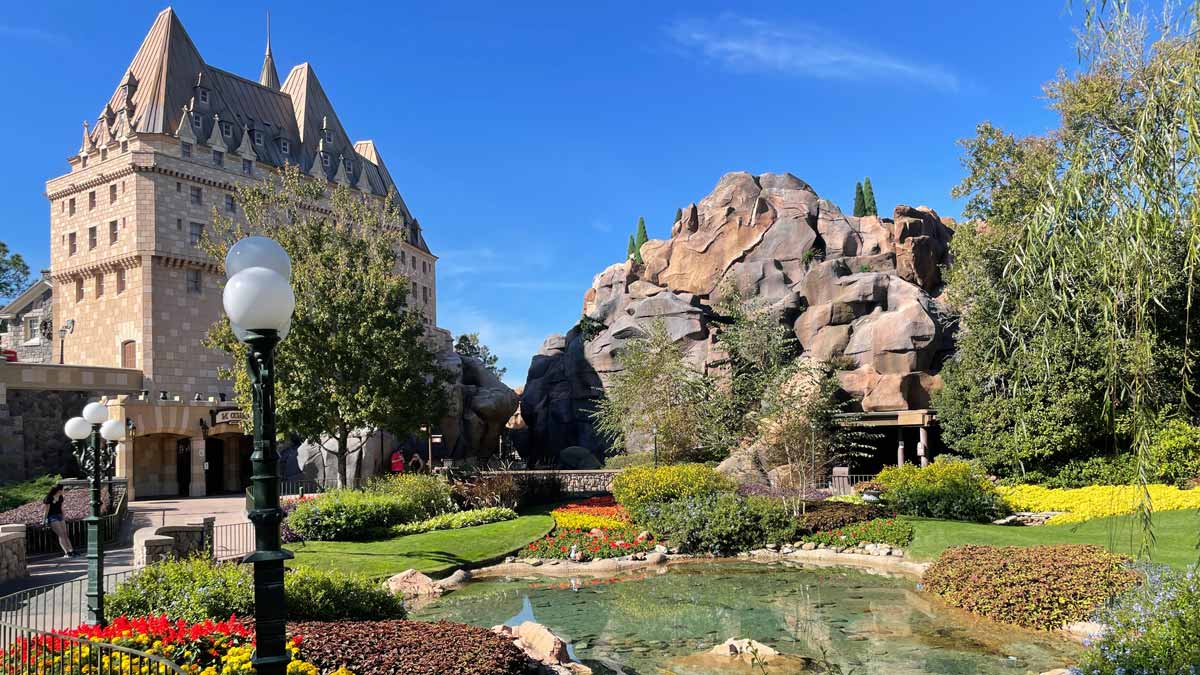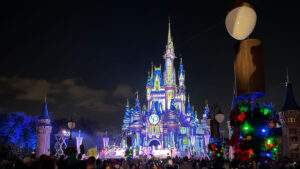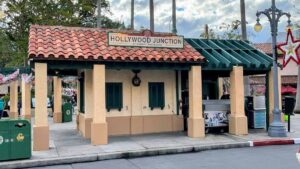Let’s go to Epcot and go the wrong way around World Showcase (amiright?!). We’ll eventually attempt to look at the architecture of every individual building at the Pavilion. But for this post I want to do an overview of… a 10,000 foot look at… an architectural opinion of… the Canada Pavilion at Epcot!
You probably already know that I am predisposed to love everything Walt Disney World. And so, I put my fake WDW ArchiGEEK stamp of approval on most posts. But, occasionally I need to review things that really should be better. And (recognizing that I’m ostracizing many Epcot superfans… sorry, EPCOT superfans [capitalized]) here, Canada should be better. #HotTake
Overall Thoughts of Canada at Epcot
Some of you are screaming at me right now. “What!? Canada’s beautiful! What is wrong with…? B…b…but, the Gardens! The Hotel Building! The TOTEM POLES!!!” And I get it. Those things that you’re yelling about are indeed stunning. My problem with Canada is not these gorgeous elements at the front of the Pavilion. It’s the rest.
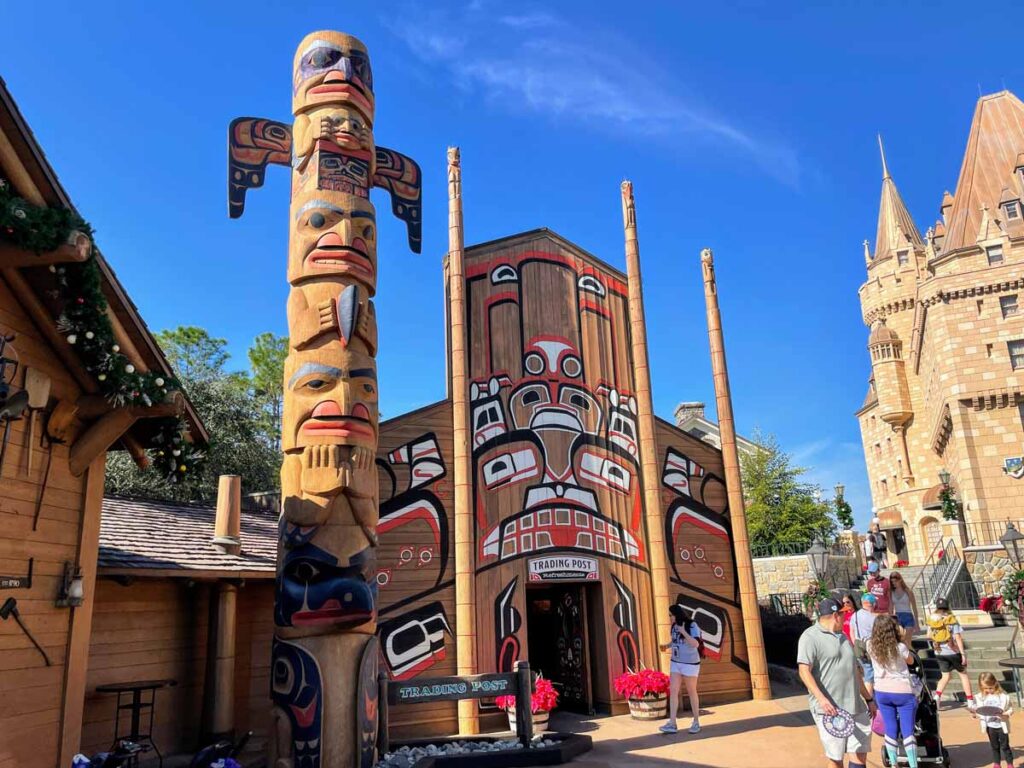
The Canada Pavilion at Epcot presents a wonderful face to those wandering around the World Showcase Promenade. It’s honestly one of the most beautifully composed views in all of Epcot.
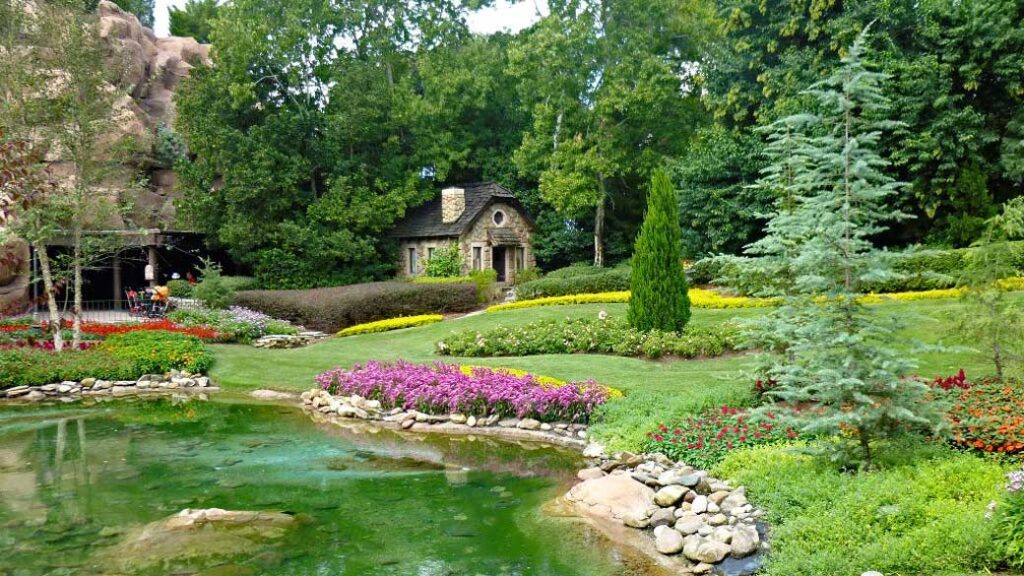
That “front” of the Pavilion consists of the wonderful, bucolic Victoria Gardens, a Northwest Indigenous village sitting above the surroundings, and the soaring Hotel du Canada overlooking it all.
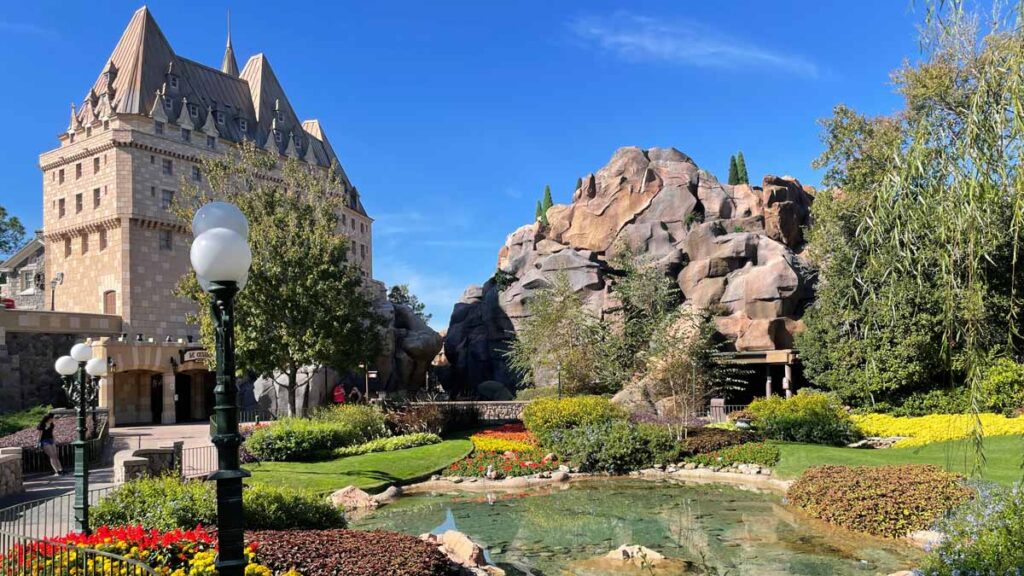
The buildings sit at romantically oblique angles to one another. The layering of elements at different heights creates variety and visual interest. But once you enter the Pavilion to explore a bit, that view we love becomes exposed as a veneer, masking a much less rich experience within. And, in this blogger’s humble opinion, it just leaves me underwhelmed.
Site Plan of Canada
It’s probably helpful to show you a site plan to explain further.
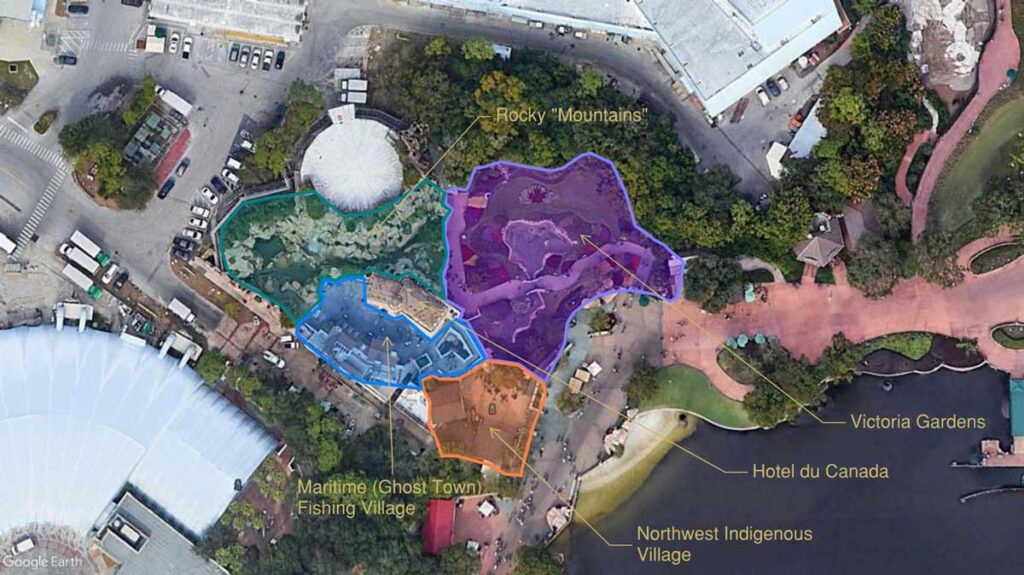
Hotel du Canada sits in the center of the Pavilion, more or less, and anchors all of the various Canada sub-lands. The Victoria Gardens serves as an immaculate “front yard” for the Pavilion. Well, it’s a backyard for those circumventing World Showcase the “correct” way. But for you rebels who go counter-clockwise, it serves as Canada’s curb appeal! The Northwest Indigenous Village (Disney called it the Northwest Indian Village in 1982, but I’m not sure if that’s going to get my site shut down today) sits 5 feet or so above the promenade on the left side, with its three totem poles and two gift shops.
The south side of the Hotel du Canada forms a small village reminiscent of the maritime towns on the eastern side of the country. This little area sits another 8 to 10 feet above the northwest village, so you do get some nice views down to the gardens and the last sub-land, the Rocky Mountains. That Rocky Mountain area makes up the rear portion of Canada, and serves mainly to mask the theater building for the Canada: Far and Wide movie.
O Canada! The Front of the Epcot Pavilion
Let’s start with the good – the front half of Canada. Like I said, it’s one of the more beautiful views in the World Showcase (although I think it’s the Popcorn Cart serving La Fin du Monde seasonally that makes it particularly gorgeous!)
Victoria Gardens
Victoria Gardens is stunning. There’s no question about it. In fact, there’s really nothing like it in Epcot.
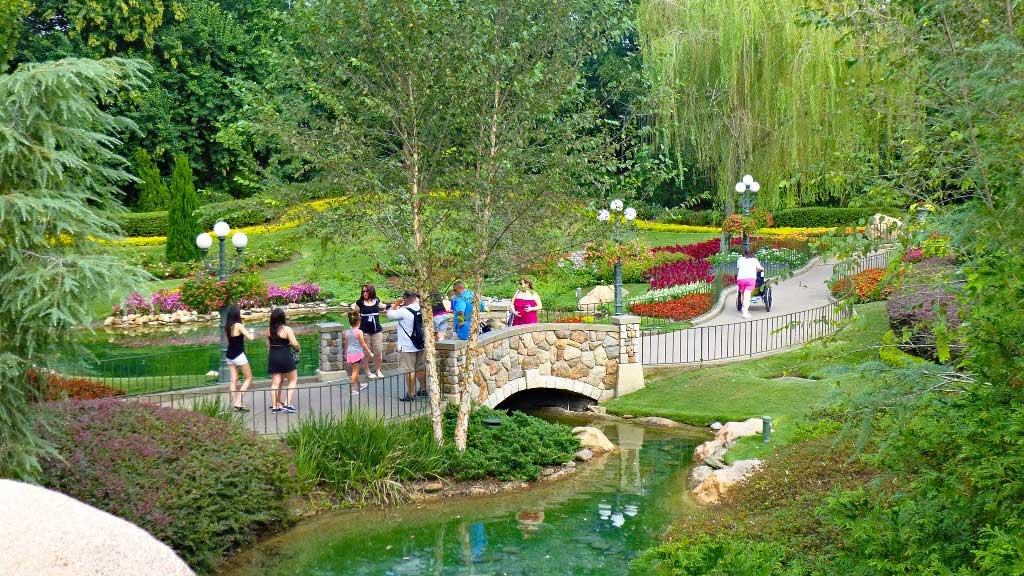
A paved path meanders through the colorful landscape, connecting the promenade with the rear of the Pavilion, accessing the Le Cellier restaurant along the way. The image above shows the small stream that runs through the gardens, spanned by a stone footbridge that helps create the romantic setting. That stream terminates in a pond that you see on the left just behind that streetlamp.
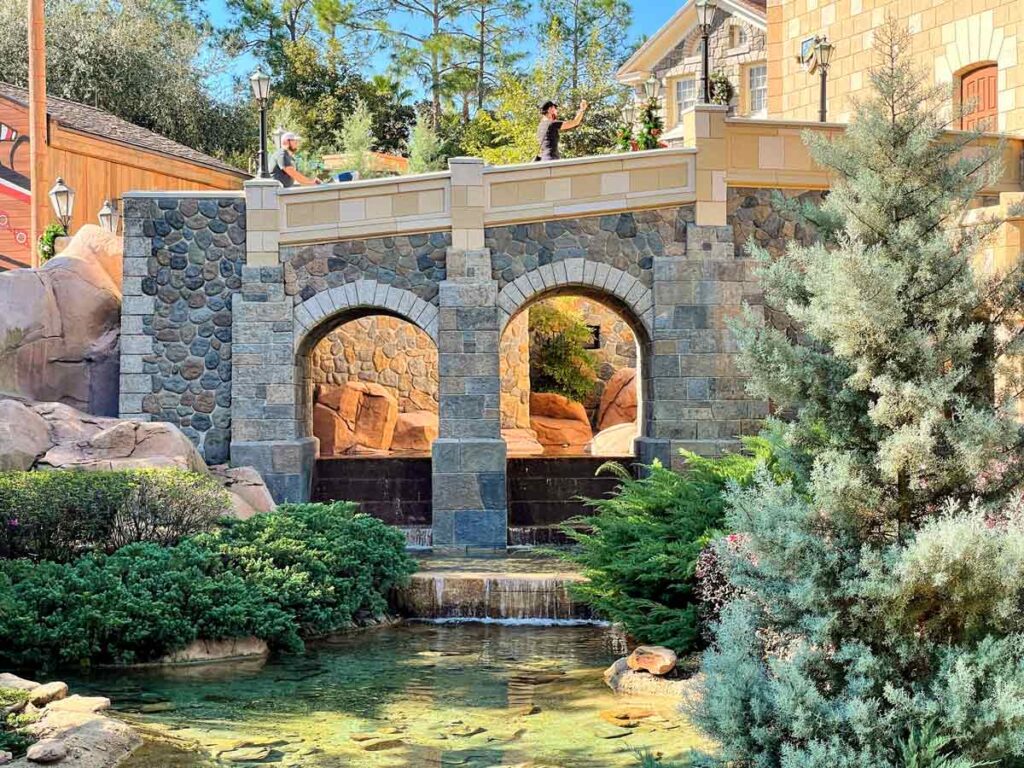
That stream begins up in the sunlit pool (seen above) behind the bridge formed by the ramp from the Northwest Village to the Hotel du Canada. In the afternoon, with the sun in the south, the pool disappears in shadow which causes this view to appear more like a grotto. I love this little moment in the landscape.
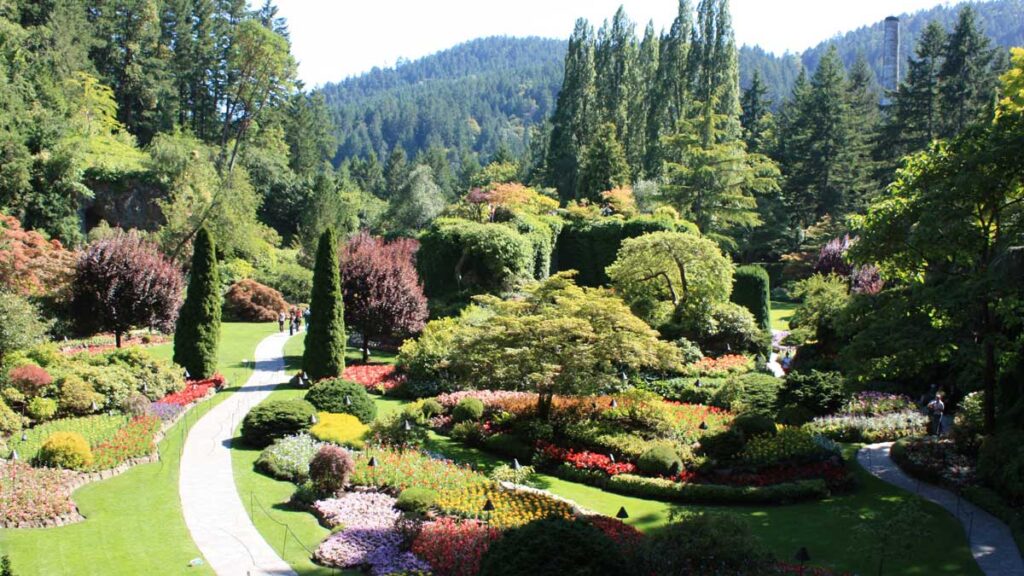
Butchart Gardens in British Columbia, considered one of the most beautiful botanical parks in the world, inspired this area of the Canada Pavilion. The original, as seen above, is much larger, and sits within a limestone quarry. But, the influence on the landscape architecture in Canada at Epcot is obvious. Much of the same vegetation, including maple trees, were used in Epcot’s version.
Hotel du Canada
Presiding over the gardens, and housing the popular Le Cellier steakhouse on its ground floor, is Hotel du Canada.
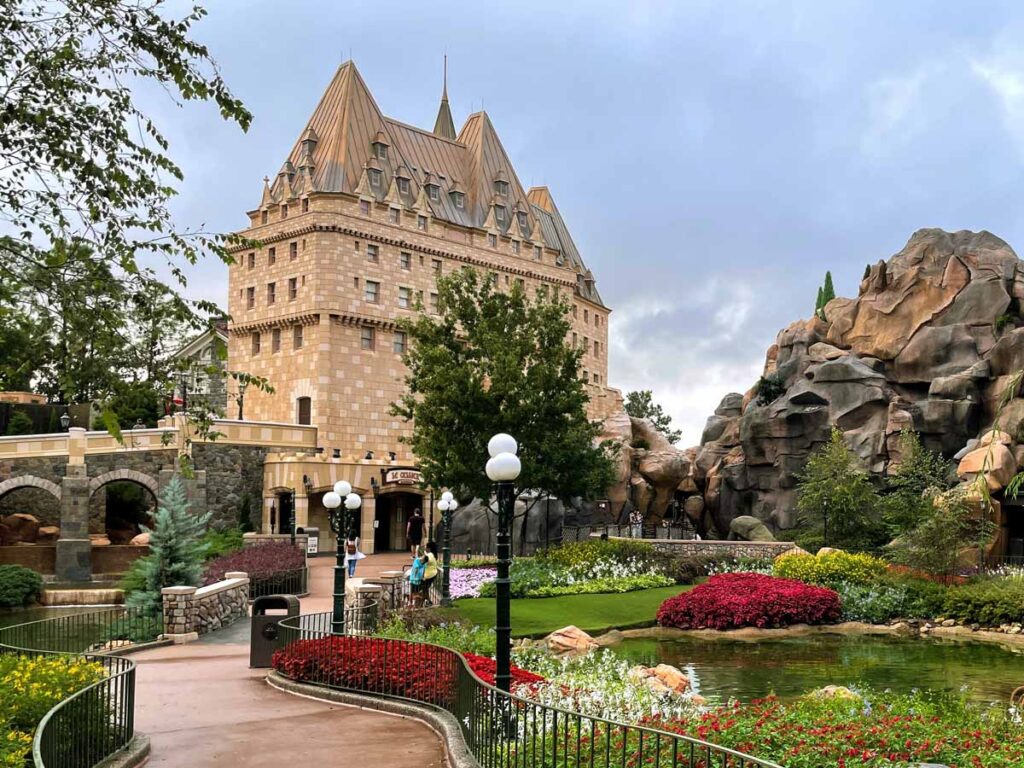
It’s elegant and sophisticated and grand and proud. We’ll cover it in detail in a future post, but the Canada landmark is one of the most memorable pieces of architecture in Epcot. Note the lack of windows on the lower levels above the restaurant. This is surely because the scale of the windows would give away the illusion of “forced perspective” that Imagineers use to make structures appear taller then they actually are. Those upper story windows are less than half the size they would be in reality. If that “trick” gets too close to real-sized things – like the restaurant entrance – the illusion can be broken. It’s made more challenging due to the fact that the second floor of the hotel becomes the first floor for the small street behind it. You can read about other Disney buildings that use forced perspective here and here.
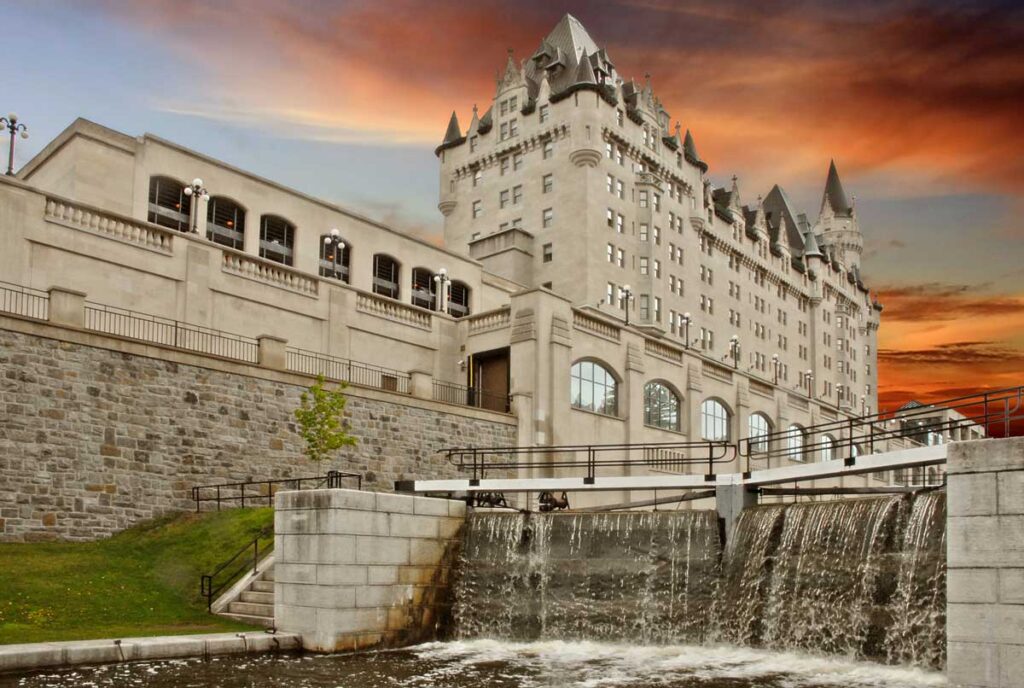
The Disney building is inspired by the real life Chateau Laurier in Ottawa, as well as other French Gothic Chateauesque buildings in Canada. It’s truly an architectural treat.
The Native Amer… er… Canadian… Indian… Indigenous Village… in the Northwest
The Pacific Northwest is the setting of the other beautiful portion of the Canada Pavilion. The slightly-raised-above-the-promenade village is rather small and quaint, consisting of three totem poles, two connected stores on one side, and some greenery on the other. But the wonderfully carved totems, which are unique to northwest indigenous tribes and retell legends or stories of important events, are enchanting and draw visitors up the stairs into the Pavilion. The two stores are directly next to each other and work well together visually, though they are two different vernacular styles.
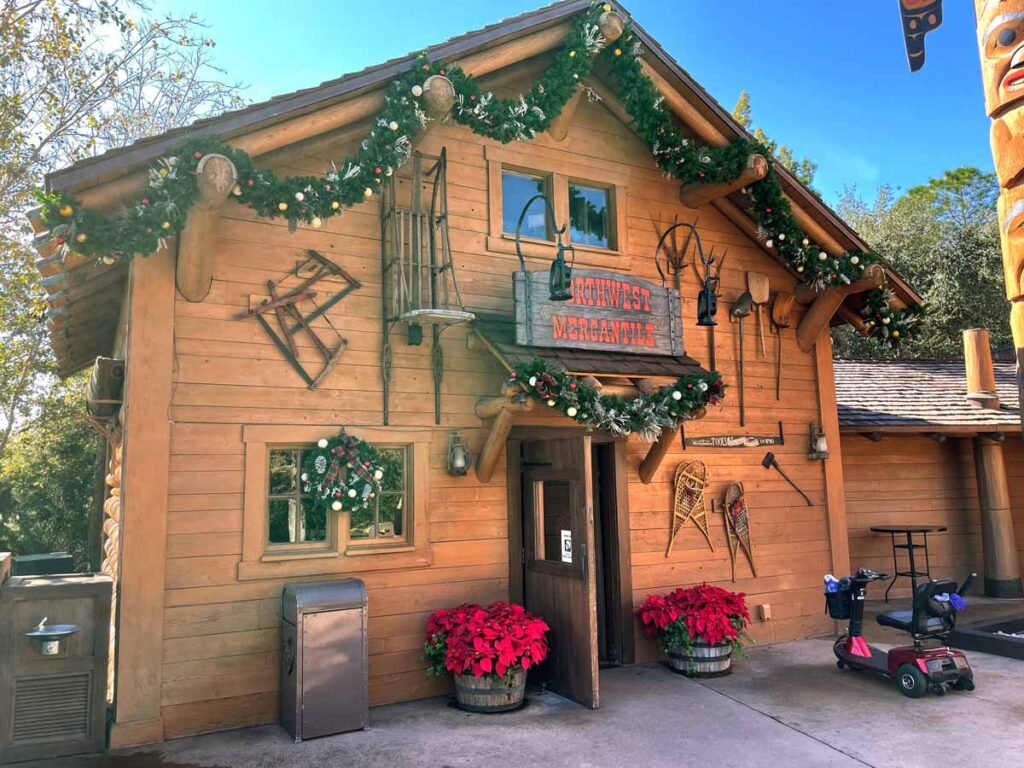
Northwest Mercantile is a timber building paying homage to explorers, trappers, and prospectors. Large protective overhangs formed with hewn logs, and winter equipment mounted to the façade set the building in the wilderness of Western Canada. In truth, according to Disney, the store is stylistically based on mid-1800s Hudson Bay architecture, where those frontiersmen blazed a trail west and north.
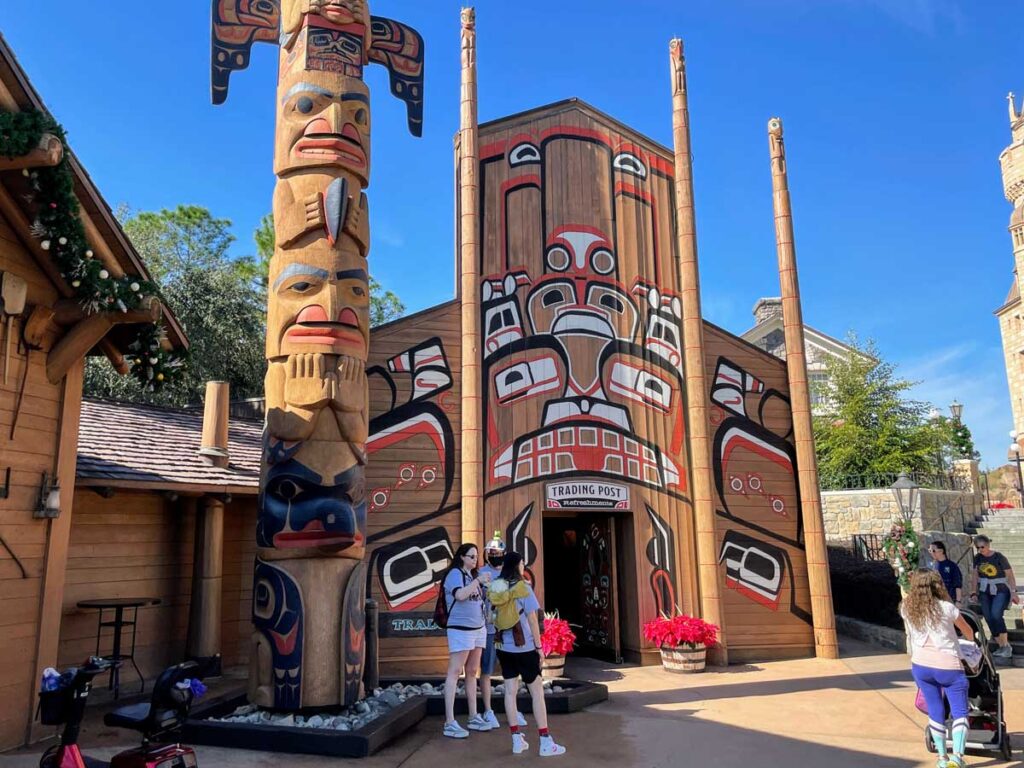
Trading Post seems to be based on a Haida Longhouse. Thinner totems break up the wooden-planked façade, with majestic native imagery spanning the entire surface. It’s unfamiliar architecture, which causes a sense of wonder and interest and draws guests into the Pavilion.
Oh No Canada! The Rest of the Epcot Pavilion
The problem is… once you’re drawn in… it’s kind of a letdown. Unlike the France Pavilion, or the Morocco Pavilion, or the United Kingdom Pavilion, or the Mexico Pavilion – all of which allow you to discover hidden gems once you wander deep enough – the architecture and theming of the rear portions of Canada at Epcot are, as I mentioned, a bit underwhelming.
Maritime Village
I don’t know what it is… when you climb a wide flight of steps, you expect to be rewarded when you get to the top. Right? Like you want to have a special view, or experience, or something great when you get there. And so, when you climb to the top of the Canada Pavilion (which is essentially the roof of Le Cellier below), it just doesn’t deliver.
Historical Precedent
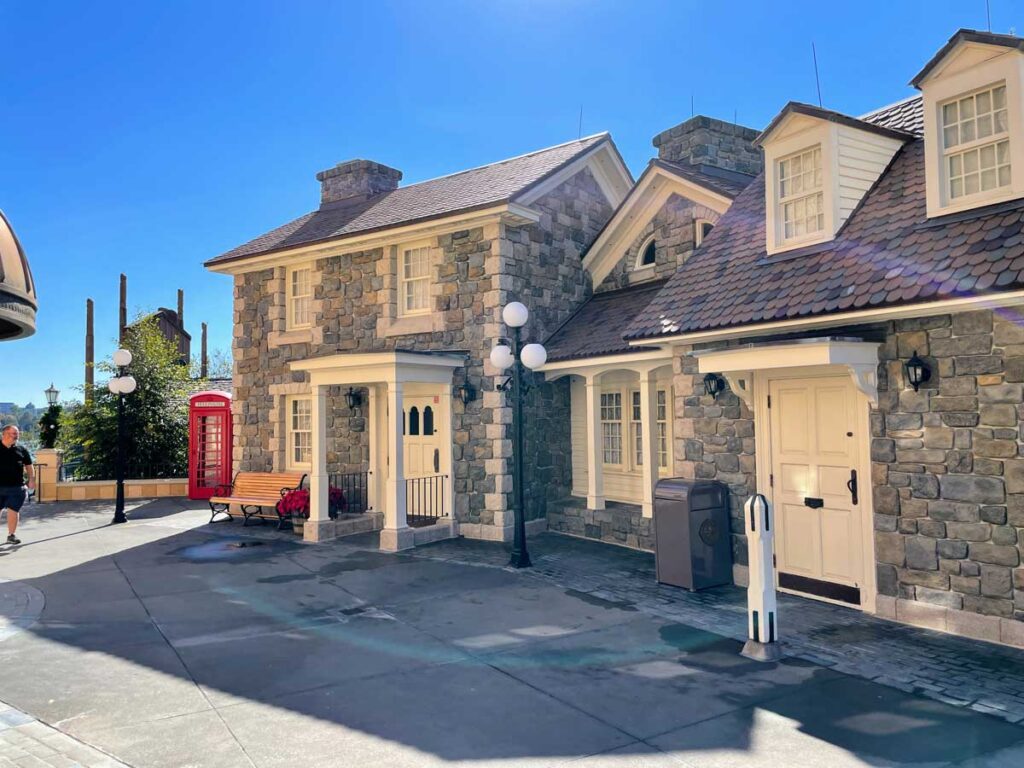
The Imagineering Field Guide to Epcot at Walt Disney World (Imagineers, Disney Enterprises, Inc., 120) says that the small village is “reminiscent of the charming maritime provinces of Prince Edward Island, Nova Scotia, and New Brunswick”. And the quaint buildings on the left side of this small street, are indeed similar to colonial houses from that region of North America, which includes New England. Abundant limestone in the rocky ground led to many stone-walled buildings.
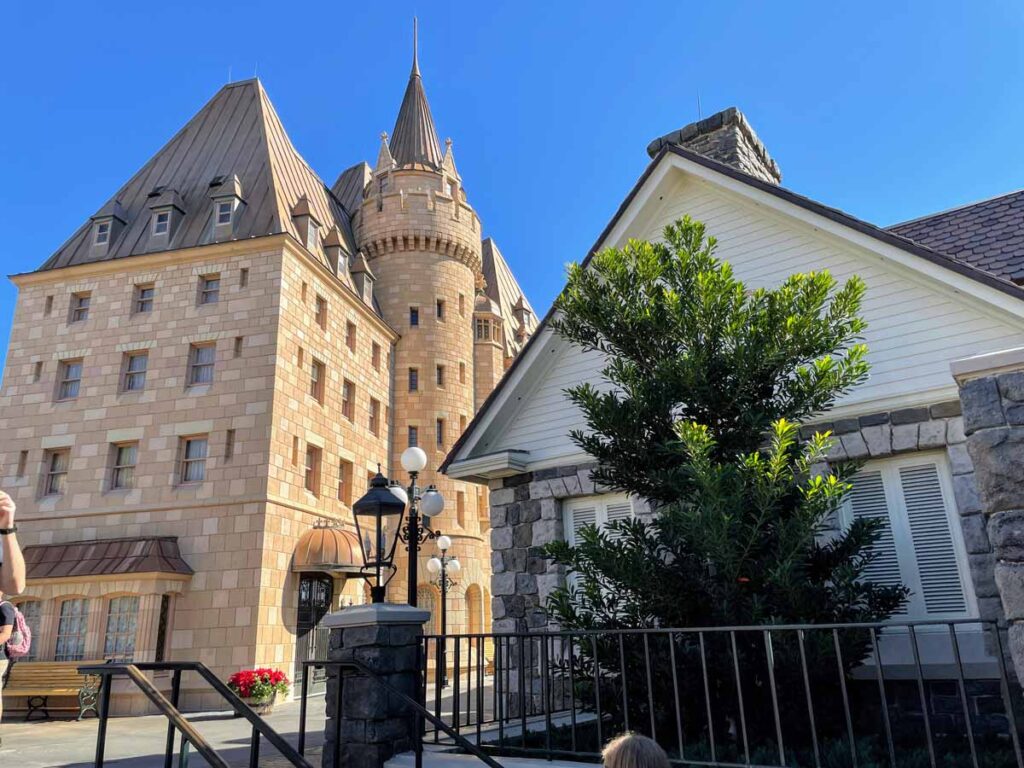
Of course, the right side of this little street has the second floor of the Hotel du Canada as its wall. With the French architecture of the hotel, and the English colonial architecture of the stone houses, this Epcot maritime village highlights the two largest cultural influences on Eastern Canada.
Ghost Town
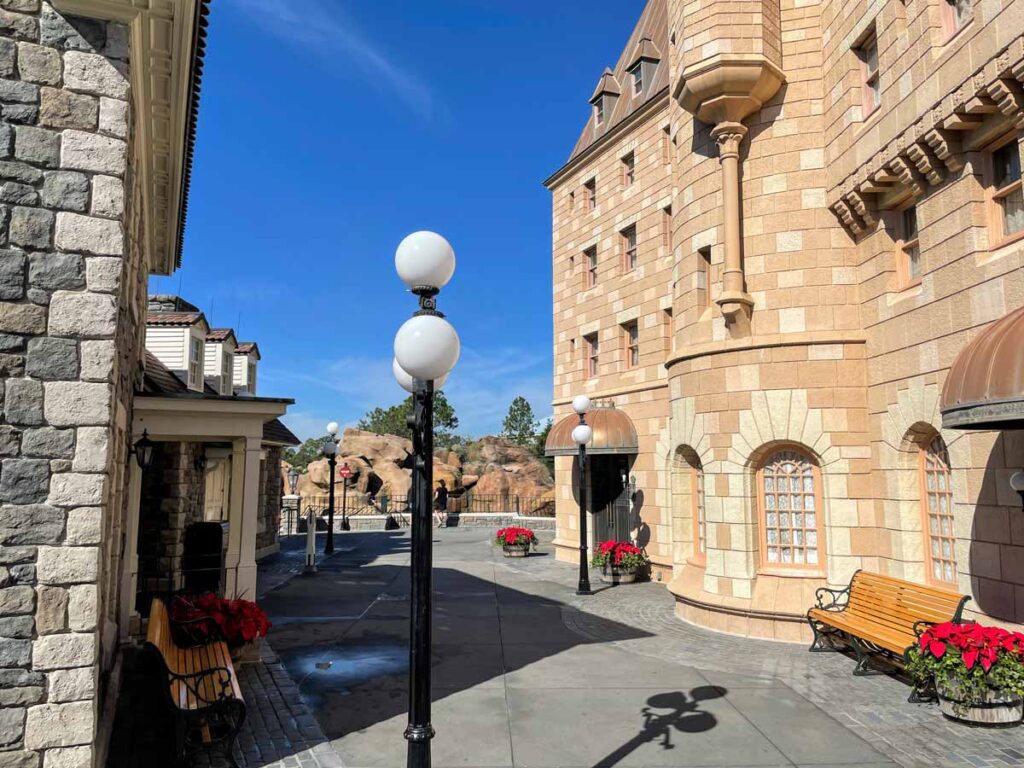
But, this village is a veritable ghost town. None of the buildings on this level have any accessible areas to enter. There are no shops, no restaurants, no attractions. Nothing. When you get to the top of the stairs, you can’t help but think, “Is this it?” Apparently, the original idea was to indeed have shops here – and there was a gift shop in the hotel for a decade or more. But, unfortunately, the larger plan never materialized.
The architecture is nice enough. And if you just want to appreciate architecture like you would art at a museum, then maybe this is your cup of tea. But, in my opinion, this area in Canada is one of the weaker areas in all of Epcot World Showcase. There’s simply no “life” up here. It’s a village where nobody lives. Contrast this with Main Street, U.S.A. in Magic Kingdom, where shops are open, “residents” walk around, and there’s activity everywhere you look. This village is disappointing.
Salmon Island / Rocky Mountains
Disappointing might not be the right word for the last portion of Canada at Epcot’s World Showcase. I think most of you think the Rocky Mountains area is pretty… pleasant… even tranquil. It is kind of cool to discover this little area. I know some call it a “hidden gem”. And if you’re looking for a quiet oasis with a waterfall in the midst of a bustling park, then I get it. But in this here blog, I’m interested in theming, architecture, and immersion. And my issue with it is that the theming just isn’t quite up to par with what the Imagineers have done elsewhere.
Exploration and Discovery
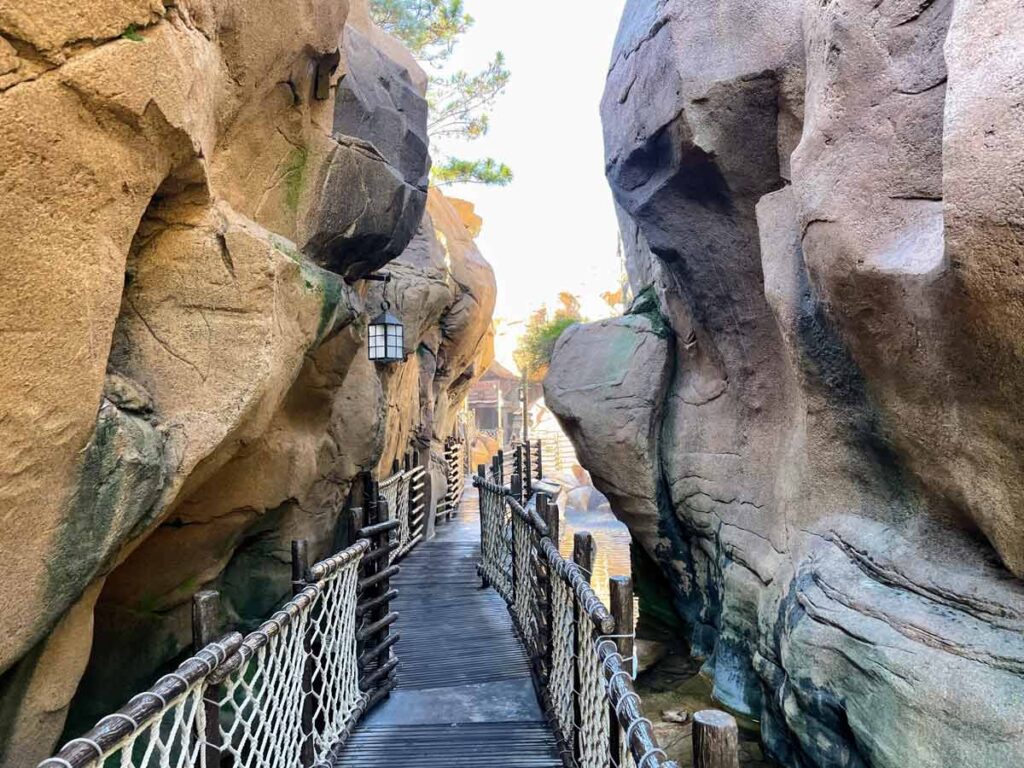
Arriving at the Rocky Mountains in the Canada Pavilion does come with a sense of discovery. You almost have to be an explorer or a pioneer to even get back there. I am, of course, exaggerating… but you almost expect a “Cast Members Only” sign to greet you when you pass Le Cellier and look past Victoria Gardens and see the narrow pass between the boulders.
Charming but Confused
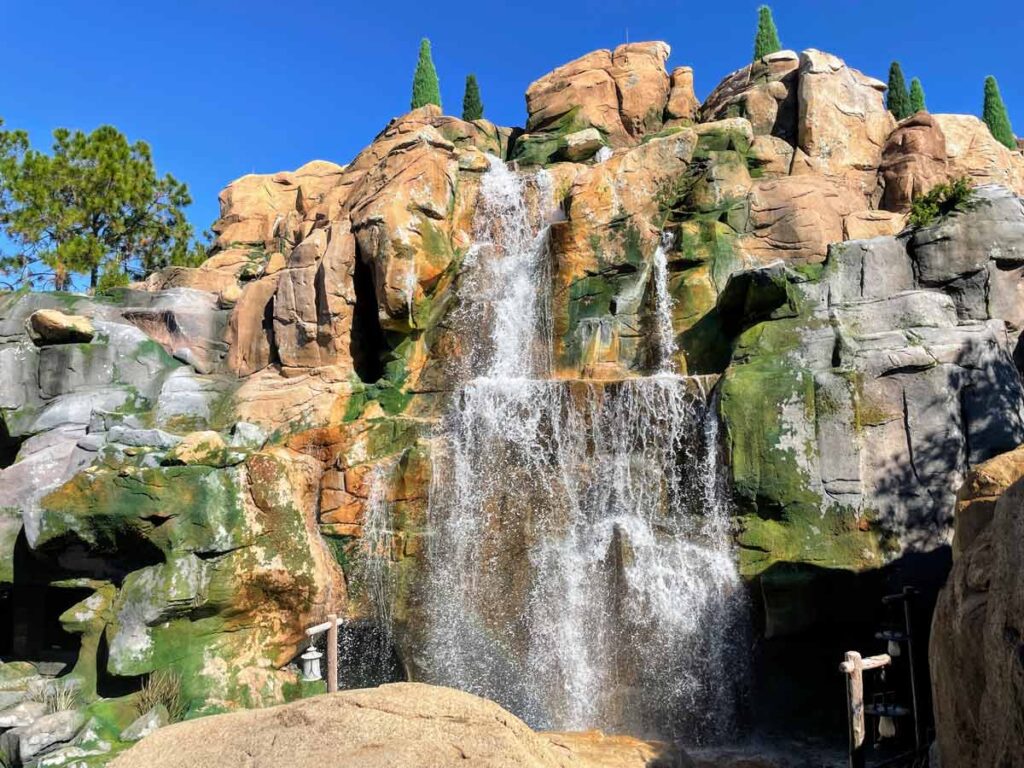
Once you get back here, it’s actually a really charming place. The problem is that it’s pretty unclear what we’re supposed to be experiencing. Some Epcot promotional materials call this rocky hill “Salmon Island”. Other sources describe this rock formation, which, as mentioned earlier, masks the Canada: Far and Wide show building, as a mountain range. The Imagineering Field Guide to Epcot at Walt Disney World (Imagineers, Disney Enterprises, Inc., 121) says that Disney’s “version of the Rocky Mountains gets the forced-perspective treatment here. These peaks, as massive as they may appear to be, could not be built at anything like actual size.”
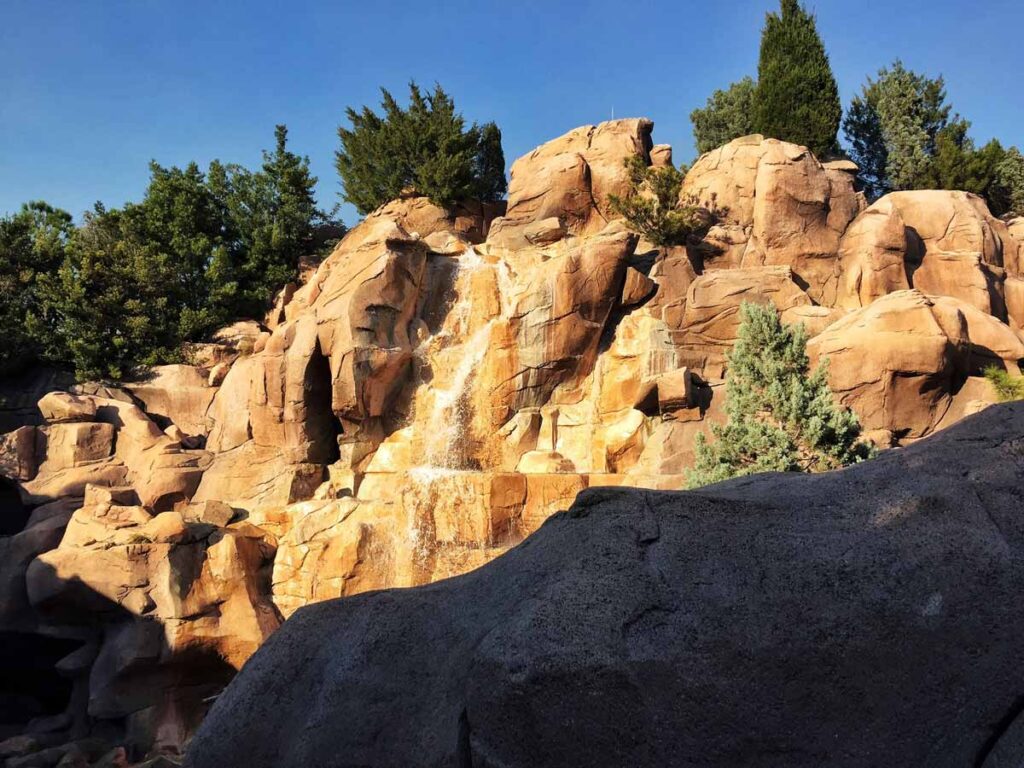
Massive mountains? Peaks… plural? Is that what you see here? The Imagineering Guide also talks about atmospheric perspective being achieved by painting distant peaks in lighter colors… I don’t see any of that. It doesn’t look like a mountain range at all. It doesn’t even look like a single mountain. Really, it looks like something you may find on a hike in my home state of Virginia.
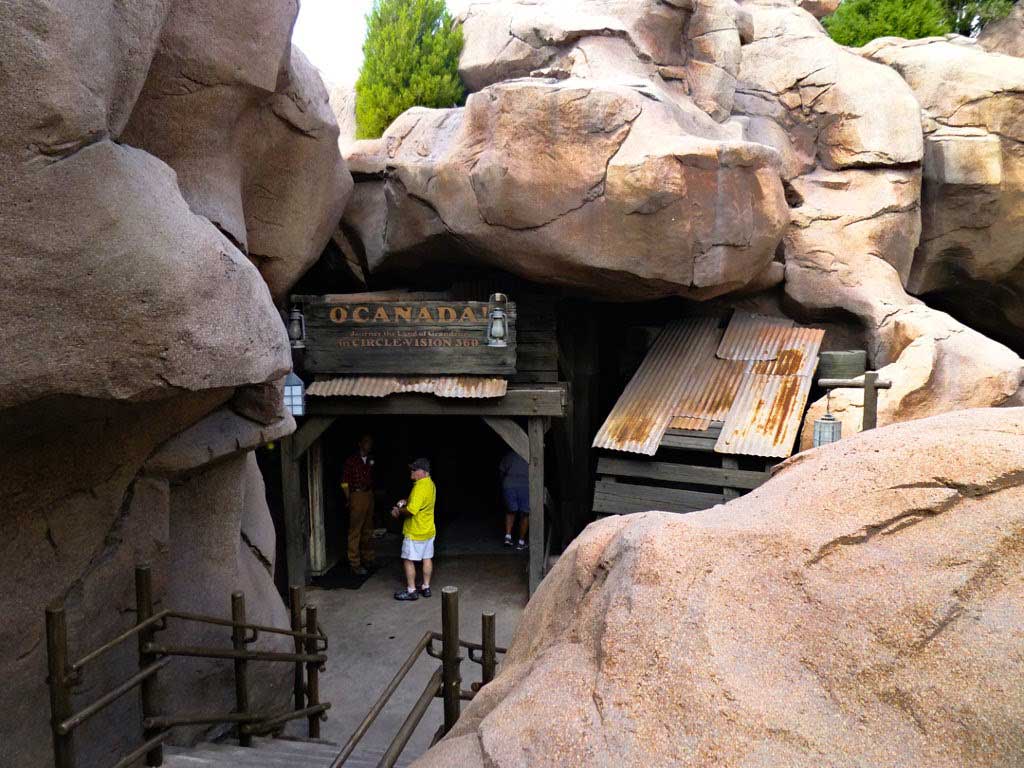
So, maybe this is why Disney calls this “Salmon Island” instead. It’s just a little rock formation surrounded by a stream (I guess with salmon) with a mine in it… But, it does seem to have a water source at the top which causes a waterfall… I just don’t get where we are. It doesn’t represent the Rocky Mountains very well, in my opinion. No matter how pleasant it is to sit and look at from the observation deck on the second level of the pavilion.
A Victim of Comparison
My guess is that if the Imagineers were designing the architecture and landscape of this area of Canada at Epcot today, they would really sell the “Rocky Mountain” theme. The rockwork at Tokyo DisneySea, Carsland at Disney California Adventure, Pandora at Disney’s Animal Kingdom, and Galaxy’s Edge at Hollywood Studios are stunningly realistic, and take the “atmospheric perspective” tricks to the highest heights. So, maybe the truth is that I’m spoiled from these more immersive environments, and that Canada just is a victim of the sin of comparison. But, regardless, it falls short to me.
Summary
Canada is a beautiful World Showcase Pavilion. No question. But, when you look at the Epcot’s Canada as a whole, it just falls short in the area of immersion and vitality. The back half of the Pavilion is just… dead. But, let me know what you think in the comments.

